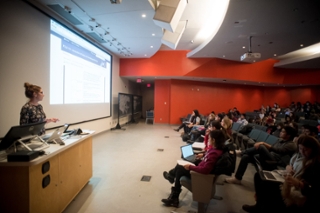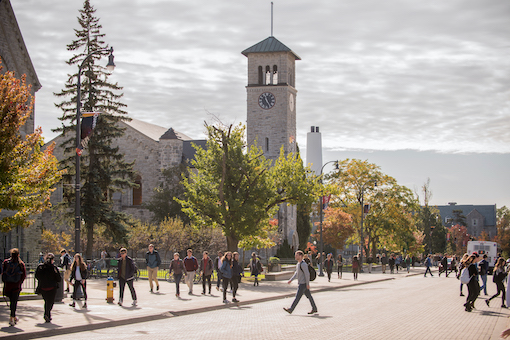
Driving Curiosity Forward – the Smith Engineering Strategic Plan
Smith Engineering is Canada's greatest engineering community: transforming engineering education and preparing students to take on the world’s greatest challenges.
Smith Engineering at Queen's offers students their choice of top-quality, technically rigorous engineering programs; home to a vibrant community of 5000 high-calibre undergraduate and graduate students from around the world. It leads Canada in graduation rates, producing engineers who become part of an outstanding alumni network.
Smith Engineering students are globally minded problem-solvers: curious; entrepreneurial, ambitious and dedicated to their community and the promise of change. They are supported by world-leading researchers; faculty who are as brilliant and committed in the classroom as they are in the laboratory.
The Faculty is comprised of five departments – Civil Engineering, Chemical Engineering, Mechanical & Materials Engineering, Electrical & Computer Engineering and the Robert M. Buchan Department of Mining – and with partner departments in the Faculty of Arts & Science offers 11 programs, as well as specialized joint programs and graduate diplomas.
The Stephen J.R. Smith Faculty of Engineering and Applied Science at Queen’s University is changing the face of engineering education, so future engineers can be leaders in the face of complex and multidisciplinary global issues, building on four key pillars:
Problem-based, experiential learning oriented toward the world’s grand challenges.
A transformative approach to engineering education needs to incorporate problem-based learning across the program to ensure students engage with others and develop novel, technically sound solutions to a broad range of societal challenges in an ethical, sustainable, and humanistic way.
A humanistic approach to engineering.
A human-centered mindset will be cultivated in students and faculty to frame problems, ensuring that knowledge and creativity are brought to solutions that will have the greatest impact, recognizing and driving “problem-solution” fit through observation, insight and empathy.
Alongside students’ grounding in fundamental and applied sciences, Smith Engineering needs to incorporate a systematic inclusion of social science and humanities knowledge.
Competency-based education to ensure subject mastery.
Program-wide competency-based education must communicate progression to students on their competence, allow students to articulate their abilities to employers and ensuring that all graduating students possess the required knowledge and skills.
This fundamental shift can provide ongoing feedback to students on their progress toward meeting all program requirements, and repeated opportunities to improve at an individualized pace, and will significantly help students articulate their skills to employers.
Experiential learning where students learn through practice.
A new model of education must provide all our students with innovative professional development and experiential learning opportunities and ensure that community and industry insight is embedded into curricular and extra-curricular experiences.
What is needed is an approach that provides significant relationship and experience within industry.
Its Indigenous Futures in Engineering (InEng) program is recognized as a nationally leading approach to support STEM education in Indigenous communities and welcome and support Indigenous students at Queen’s. This model has instigated two other important initiatives at Queen’s: STEMInA, a campus-wide program to support Indigenous students in all areas of STEM education, and Black Youth in STEM, an outreach and support program for Black youth.
It is also at the forefront of education innovation with the recent introduction of its Mechatronics & Robotics Program; a novel college-to-university bridging pathway; and the creation of research centres including the Beaty Water Research Centre and Ingenuity Labs, a globally recognized AI and robotics research hub.
From a storied past as one of Canada’s original engineering schools, the Faculty has its eyes set firmly on the future.

Driving Curiosity Forward – the Smith Engineering Strategic Plan

Engineering thrives on diversity.
Dr. Kevin J. Deluzio, BSc, (Mathematics and Engineering), MSc, PhD (Mechanical Engineering) Queen’s University, was appointed Dean of the Faculty of Engineering Applied Science in June 2017, and reappointed in 2022.
As Dean of Smith Engineering, Dr. Deluzio is committed to the evolution of engineering education at Queen’s, putting the Faculty on a path to ensure that its graduates are empowered to take on the world’s greatest challenges. This includes equity in the academy as well as the profession: Dean Deluzio is a strong champion of equity and diversity in engineering, dedicated to the idea that equity-deserving groups, including women, are fully represented both in universities and as practicing engineers.
In addition to his work as Dean, Dr. Deluzio is an award-winning teacher, a Professor of Mechanical Engineering and Head of the Human Mobility Research Laboratory at Queen’s University. Prior to his appointment as Dean, Dr. Deluzio was the head of the Department of Mechanical and Materials Engineering from 2014-2017 and has been a faculty member at Queen’s since 2006.
Dr. Deluzio is a Professional Engineer and is internationally recognized for his research in human motion and orthopaedic biomechanics.
Dr. Deluzio has been Chair of Engineering Deans Canada (2021-23) and currently serves as Past Chair. He is a Fellow of the Canadian Academy of Engineering; the Engineering Institute of Canada; and the Canadian Society for Biomechanics, from which he also received the Career Award in 2022. He has also served on the executive of the Canadian Society for Biomechanics, as president of the Canadian Orthopaedic Research Society, and on national grant review panels.
From our origins as the School of Mining and Agriculture in 1893, to our amalgamation into Queen’s University, learn more about the history of Smith Engineering.